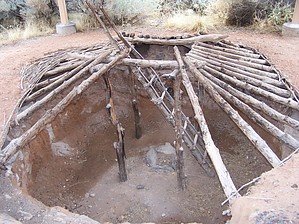
In Boulder, Utah, the Anasazi Village State Park offers the chance to see something that isn't common across the Colorado Plateau; a restored Anasazi village. In the late 1200's the fertile valley that now contains the Mormon settlement of Boulder was home to some of the northernmost Anasazi villages. Owing to their location, this area was likely a mixing pot between the Virgin and Kayenta Branches of the Anasazi, and the neighboring Fremont Culture. Now one of these sites is on display for the public at Anasazi Village State Park. The trail starts at the rear of the small but excellent museum. The trail is short, but if you need to top off your water bottle there is a water fountain at the museum.
Almost immediately after leaving the museum, on your left, is a the village. This village is not the actual village that the Anasazi inhabited. What the park's scientists have done is recreate the actual village, which is further on the trail, as it would have appeared while it was occupied, but in an area that would still allow for the exploration and study of the ruins. You are free to enter into the buildings, peer in the doors, and look at the craftsmanship of the walls. The techniques used to build this village are exactly the same as were used in the 1200's. If you have been to places like Mesa Verde or Betatakin, compare the masonry work. Here the blending of Fremont and Kayenta styles is most apparent to the untrained eye.
Moving on further down the trail there is a large shelter over a section of ground, similar to the cover over Casa Grande. Unlike Casa Grande's Big House, hardly anything remains of the original village that stood on this spot. The cover protects the foundations, which are exposed for viewing, from summer monsoons and winter snows (both of which can be quite harsh). It is really quite amazing to look at the remains of those rooms and think of the people who live and died, loved, hoped, dreamed, and eventually left in this same spot all those hundreds of years ago. Would they have any idea that in 800 years, all that would remain would be some stones and posts? After you have finished exploring the ruins, return to the museum by the path by the restored village.
 Route Editor
Route Editor




